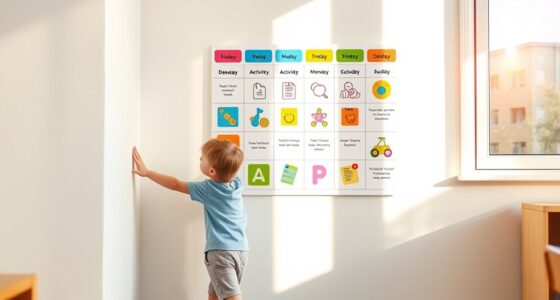When your child throws a tantrum at the grocery store, stay calm and use clear, gentle instructions to guide them. Set expectations beforehand, offer choices, and praise good behavior to reinforce positive actions. Maintain a consistent routine to help your child feel secure and reduce outbursts. If issues escalate, redirect their attention or take a brief break outside. Keep learning more tips to handle these situations smoothly.
Key Takeaways
- Use a calm, consistent approach to manage tantrums without punishment or harsh discipline.
- Set clear expectations and communicate rules before entering the store to promote understanding.
- Establish routines and praise positive behavior to create predictability and reduce tantrums.
- Offer choices and involve children in shopping to empower them and minimize frustration.
- Address escalating tantrums early with redirection, brief pauses, and calm responses to teach self-regulation.

Going shopping with young children often tests your patience, especially when they start throwing tantrums in the middle of the grocery store. In these moments, your ability to manage behavior and communicate effectively becomes essential. Instead of feeling overwhelmed or frustrated, you can use a calm, consistent approach to navigate the situation. Behavior management isn’t about punishment; it’s about guiding your child toward understanding what’s expected and helping them regulate their emotions. When your child begins to act out, take a deep breath and speak in a gentle but firm tone. Let them know you understand they’re upset, but remind them of the rules and what’s acceptable. Clear, direct communication helps your child feel heard and understood, reducing the likelihood of escalation. For example, if they refuse to sit in the cart or become disruptive, calmly explain, “We need to stay seated so we can finish shopping quickly.” This approach sets boundaries without raising your voice or resorting to harsh discipline. Additionally, creating a consistent routine can help your child feel more secure and reduce the chances of a tantrum by establishing predictability.
Effective communication is key to preventing future tantrums. Before heading into the store, set expectations with your child. Discuss what you’ll be doing, what behaviors are acceptable, and what will happen if they misbehave. Keep your instructions simple and age-appropriate, and involve your child in the process. For instance, say, “When we shop, you can walk beside me and tell me if you’re hungry or tired.” This way, they feel involved and understand their role. During the shopping trip, reinforce positive behavior with praise. If your child listens, stays calm, or helps find items, acknowledge it with a smile or a kind word. Positive reinforcement encourages them to repeat good behavior and makes the outing more pleasant for everyone.
If a tantrum begins to build, don’t ignore it. Address it early by redirecting your child’s attention or offering a choice. For example, if they’re upset about a specific item, suggest, “Would you like to help me pick out the apples or carry the shopping list?” Giving choices empowers your child and helps them feel in control, reducing frustration. If a tantrum becomes intense, it’s okay to take a brief pause outside the store or in a quiet corner. Use that time to calm your child and yourself. Remember, consistency is key—responding calmly and predictably teaches your child what to expect and how to behave.
Ultimately, managing a tantrum in the grocery store relies on your ability to stay composed, communicate clearly, and set expectations upfront. By applying these strategies, you can transform a challenging outing into an opportunity for your child to learn self-regulation, and you to strengthen your parenting skills.
Frequently Asked Questions
How Can I Prevent Tantrums Before They Start?
You can prevent tantrums by using calming techniques and distraction strategies before they start. Recognize early signs of frustration and calmly address them, perhaps with deep breaths or gentle reassurance. Keep your child engaged with interesting distractions, like talking about what you’re shopping for or offering a favorite toy. Planning ahead and staying calm yourself helps create a positive environment, reducing the likelihood of tantrums erupting during your grocery trip.
What Signs Indicate My Child Is About to Tantrum?
You notice your child showing emotional cues like fidgeting, deep sighs, or avoiding eye contact, which signal a tantrum may be near. Physical signs such as clenched fists, tense muscles, or a flushed face also indicate escalating frustration. When you see these signs, it’s important to gently intervene or offer comfort to help your child manage their emotions before a full-blown tantrum occurs.
Are There Effective Rewards for Good Behavior?
Think of positive reinforcement as planting seeds that grow good behavior. You might reward your child with praise or a small treat when they behave well, like using a sticker chart for consistent routines. Research shows that consistent routines combined with effective rewards boost cooperation. So, when your child follows rules, celebrate their efforts, and you’ll see more of that good behavior blossom.
How Should I Handle Tantrums in a Crowded Store?
When your child has a tantrum in a crowded store, stay calm and use store aisle distractions to redirect their attention. Engage them with a quick, calming technique like deep breaths or a gentle voice. Keep a steady, reassuring tone, and avoid escalating the situation. If needed, step aside to a quieter spot, giving your child space to cool down before continuing shopping.
When Is It Necessary to Leave the Store Early?
You should leave the store early when your child’s tantrum turns into a safety emergency. If they threaten to run into the emergency exit or become uncontrollable, it’s time to prioritize safety over store policies. While it’s ironic, sometimes following store rules isn’t enough—your child’s well-being comes first. Exit calmly, alert staff if needed, and return when everyone’s ready, because safety always trumps shopping plans.
Conclusion
Next time your little one has a tantrum in the grocery store, remember it’s just a bump in the road. Stay calm, keep a steady voice, and imagine the peaceful checkout line you’ll enjoy once they settle down. If you think everyone’s judging you, focus on your goal: teaching patience and resilience. Before you know it, those tantrums will be rare, and your grocery trips will become smoother, leaving behind memories of growth rather than chaos.









